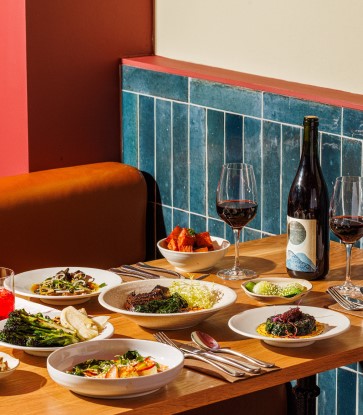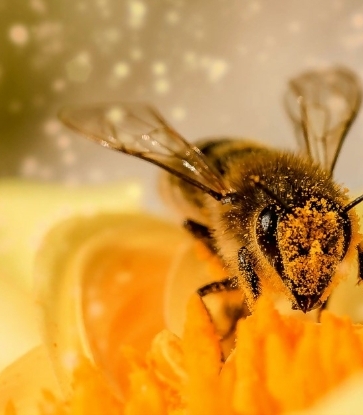Words like ‘organic’ and ‘biodynamic’ have become increasingly used in recent years when talking about how our food and drink is produced, but do we really know what they mean and why they’re so important to the future of our food chains?
Quite simply, any words we use when talking about the sustainability of our food systems links back to one thing: the soil.
95% of the world’s food originates from soils, with soils supplying 15 of the 18 naturally occurring elements that are essential to a plant’s survival. However, due to the way that we live and the way that we farm – with mass urbanisation encroaching on and covering up soils; intensive farming practices eroding and leaching the goodness from the land; and industry clearing away huge swathes of natural landscapes – we’ve degraded the quality and availability of our soils and made some of them virtually redundant.
According to the United Nations’ Food and Agricultural Organization, a third of the world’s soil is now moderately to highly degraded. And without soil, we can’t grow food. Whether it’s through erosion or compaction; pollution or acidification; water logging or increasing salinity; nutrient imbalance, lack of organic carbon or loss of soil diversity – our soils need our help to be able to continue producing crops and supporting life.
Resetting the system isn’t an option, but we can try to lower our human impact – while also looking to nature for our inspiration and attempting to mirror the ways that natural ecosystems operate. Modern farming techniques include the likes of crop rotation and planting cover, catch and companion crops, as well as using mulch as a protective barrier and adding organic matter to the soil through green manure.
Sitting at home this might seem much bigger than us, but on a smaller scale we all have a part to play through our daily lives – and that comes down to the food that we choose to eat, as well as the places that we choose to buy and eat it. By making better choices, we can help support farmers, producers and chefs who are doing things the right way.
Below are nine of the Inspectors’ favourite restaurants whose chefs follow either a kitchen-garden-to-table or a farm-to-table ethos, helping make the world a more sustainable place while at the same time offering some truly delicious – and because of the way it's grown, more nutritious – food.

Allium at Askham Hall, Askham, Cumbria
One Michelin StarDishes served in this country kitchen style restaurant, situated in the famous 11th-century castle, are driven by the seasonal availability of produce from the Lowther Estate in which it sits. Head Chef Richard Swale works closely with the gardener, who advises him on which ingredients are at their peak and what should be planted next. Fruits include apples, plums and raspberries; vegetables include beetroot, radishes, carrots and leeks; while wild garlic grows along the banks of the River Lowther. Animals reared here include rare breed pigs, chickens and shorthorn cattle, with deer, rabbits, grouse and pigeons from the woods and moors. Pickled, dried, salted or left to rest in the ground, preserved fruits and vegetables also play a big part on the menu.

Gravetye Manor, East Grinstead, Sussex
One Michelin StarThis quintessentially English country house is surrounded by 35 acres of glorious gardens and was once the home of pioneering gardener William Robinson. The kitchen garden provides the restaurant’s heartbeat – if it’s not in season, you won’t find it on the menu – and the chefs really know how to get the best out of their produce. Carefully crafted dishes appeal to both the taste buds and the eyes, with their fresh, vibrant flavours and appealingly colourful presentation. Tours of the historic garden are also available.
Where to Stay: Gravetye Manor (Two Michelin Keys)

Interlude, Lower Beeding, Sussex
One Michelin Star and a Michelin Green StarThis intimate, elegant restaurant lies within the historic 240-acre, Grade I listed woodland gardens of the Leonardslee Estate, which were first planted in 1801 and are now open to the public and famous for their azaleas and rhododendrons, as well as their free roaming deer and wallabies. The ever-changing Interlude menu is guided by what produce is available at any one time in the vegetable gardens and what can be foraged from the woodland; these ingredients are then brought to life in Chef Jean Delport’s skilfully crafted, highly original dishes.
Where to Stay: South Lodge Hotel & Spa

John’s House, Mountsorrel, Leicestershire
One Michelin StarThe 4,000-acre Duffin family farm in Mountsorrel plays host to a 16th-century farmhouse – where the eponymous John was born and now cooks – along with a shop, a café, a petting farm and a motor museum. It’s a real family affair, with his parents, brother and sister all involved. The surrounding fields supply most of the ingredients, from herbs, vegetables and fruits to lamb, pork and beef. Butchery takes place on-site and they use every part of the animal; rare breeds are a feature and include Leicester Longwool sheep and Gloucester Old Spot and Tamworth pigs. John has a great appreciation for his ingredients and certainly knows what it takes to get the best out of them.

L’Enclume, Cartmel, Cumbria
Three Michelin Stars and a Michelin Green StarAlso: Rogan & Co – One Michelin Star
Simon Rogan’s 12-acre working farm in the Lake District is designed by chefs for chefs and is dedicated to providing fruits, vegetables and herbs as well as chickens, ducks, pigs, sheep and cattle for his various UK restaurants. It’s a sustainable operation, which returns animal waste to the land to be used as compost and ensures that Simon’s restaurants leave as low a carbon footprint as possible. Ingredients are grown organically and, with harvest-to-plate often taking place in less than an hour, their quality and freshness is unbeatable. Simon enjoys experimenting with growing unusual and exciting ingredients, such as Japanese wineberries, elkhorn fern and buck’s-horn plantain.

Le Manoir aux Quat' Saisons, Great Milton, Oxfordshire
Two Michelin Stars and a Michelin Green StarLegendary French chef Raymond Blanc presides over this iconic restaurant, where beautifully fresh seasonal ingredients from the kitchen garden underpin the skilfully executed classical French cooking. Raymond is passionate about growing his own produce and diners are encouraged to visit the gardens – which contain hundreds of different herbs and vegetables – as well as the 2,500-tree orchard. Those wishing to gain inspiration for their own allotment or vegetable plot can even attend a gardening course here.
Where to Stay: Le Manoir aux Quat'Saisons, A Belmond Hotel, Oxfordshire (Three Michelin Keys)

Moor Hall, Aughton, Lancashire
Three Michelin Stars and a Michelin Green StarProduce grown in their no-dig beds leads the menu at this ultra-modern, glass-fronted restaurant. Like the original 16th-century house and the rest of its charming grounds, the walled kitchen garden is a thing of beauty, but it's also sustainable, with food waste returned to the soil, a bee hive population helping with pollination and natural wildlife controls encouraged. The Head Gardener keeps in close contact with Chef Mark Birchall to discuss what’s growing and what’s at its peak for harvesting, and also runs tours for the public.

The Black Swan, Oldstead, North Yorkshire
One Michelin Star and a Michelin Green StarAlso: Roots – One Michelin Star
This characterful pub is owned by the Banks family, who have lived and farmed in North Yorkshire for generations: Tommy heads up the kitchen, while brother James is in charge of front of house. Much of the produce for the pub – and for their second restaurant, Roots, situated in York – is grown on 30 acres of their parents’ farm. They also have two acres of growing beds and terraces in the garden adjoining the pub and search out other ingredients by foraging in the hedgerows and woodland in and around Oldstead. The modern menus are very much driven by the seasonal availability of the incredibly fresh produce and the team also like to experiment with different ingredients to find new ways to use and preserve them.

The Forest Side, Grasmere, Cumbria
One Michelin StarThe team at The Forest Side have a passion for fresh, local and sustainable ingredients and this Lakeland mansion’s one-acre kitchen garden – planted with over 100 varieties of vegetables, 25 types of herb and various micro-greens – plays a large part in the dining experience. The team say that ‘Forest Side is designed to be a reflection of the landscape in which it sits’, and on the hyper-seasonal menu you'll find wild ingredients foraged from the surrounding fells, forests and lakes by Chef Paul Leonard and his team.
Where to Stay: The Forest Side Hotel (One Michelin Key)

Hero Image: Gravetye Manor, where ingredients are plucked fresh from the kitchen garden before arriving on your plate (© Claire Takacs)



















